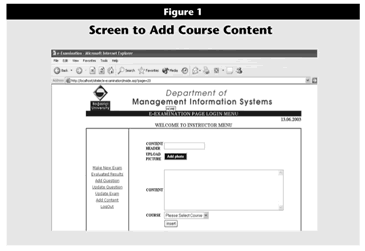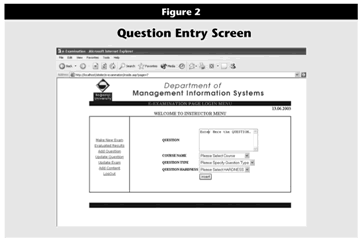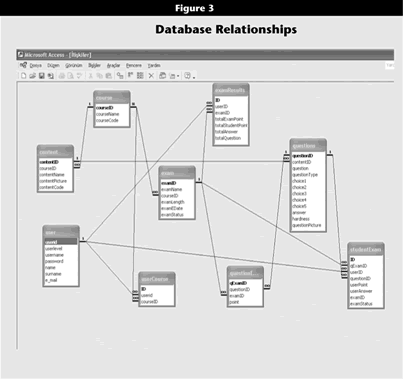Many universities are reevaluating their traditional educational methods and providing pedagogical material through the Internet.1 Some Web-based systems offer a constructionist learning environment, for example, where students can learn by designing their own objects.2 Providing effective, convenient technology to support learning is important, and the Web offers multiple opportunities for the academic who wants to take advantage of its capabilities in teaching and engaging students.
The most popular support tools are Internet chat applications. They exist in endless variations, such as Internet Relay Chat (IRC). Chat is used for education and pleasure and sometimes replaces the phone as a means of communication.3
An electronic support system was developed specifically to provide Web-based support for students and instructors in the Management Information Systems (MIS) Department at Bogaziçi University in Turkey. Because of its flexibility, the resulting system, called MISESS, could easily support other departments and other universities wanting to offer course materials, exams, and tutorial services online.
Objectives and Benefits
The MISESS project aimed to facilitate the work of the department’s teachers and students and to enrich educational content by ensuring that they would have access to all classes, related subject matter, and examinations electronically. Students should be able to access the system from anywhere and at any time, and instructors should be able to upload course documentation, handouts, exams, class notes, and questions without constraints.
The MISESS online environment lets students study materials from a large database of course subjects and take exams constructed from questions provided in a question database. MISESS also creates Web pages that ensure feedback and assessment, and the system produces instructions to help students understand subjects more deeply.
MISESS requires user authentication. Each user is given a username and a password as defined by the system administrator. Registered students have rights granted by the system administrator to read course documentation and participate in specified exams. Registered instructors can add and update class notes, upload questions, delete questions, prepare exams, and upload exams. Instructors can set exam criteria such as duration, difficulty level of the questions, or date by which students must take the exam. Some types of questions and their answers are evaluated by the system, while the instructor evaluates other types manually. At the end of an exam, students can see their grades and the relevant class notes with reference to their mistakes.
The expected benefits from this system can be summarized as follows:
- Making classrooms more geographically and demographically available.
- Providing a mechanism for distribution of the courses over the Internet.
- Accessing all the MIS courses at the students’ request.
- Converting all types of classical exams to electronic types in a short period, including
- creating the most efficient examination system on the Internet, and
- minimizing the time spent to prepare an exam.
- Increasing the students’ knowledge of the course material.
Methodology
A structured methodology underlies the building of MISESS. Structured methodologies are top-down, progressing from the highest, most abstract level to the lowest, detailed level. “Structured” refers to the step-by-step techniques employed, with each step building on the previous one.4 The MISESS development procedure relied on two major types of analysis: system users’ requirements and system components.
System Analysis 1: System Users
MISESS was designed according to the use requirements determined by examining the following groups:
- Students
- Instructors
- System administrators
- Net surfers
The resulting requirements were defined based on literature surveys, meetings with the instructors, and the developer’s personal experiences in undergraduate and graduate teaching.5
Analysis of Students’ Requirements. The system originally was intended for MIS students to use in their courses, midterms, quizzes, and final exams. The following functions are needed to satisfy students’ requirements:
- Log in. Registered students log in to the system to reach the course contents or take exams.
- Change password. Students can change their passwords on request.
- Read course content. After the username and password are verified, students can see content of the courses for which they have registered.
- Take exams. Authenticated students take the exams open to them.
- See exam results. Authenticated students can see the results of the exams they have taken.
- Log out. Students log out of the system to end a session.
Analysis of Instructors’ Requirements. Instructors’ primary purpose in using this system is to provide lecture notes and give students online exams, which they create using the system itself. The following system functions satisfy these requirements:
- Log in. To create and offer content or exams to students, the instructor must first log in to the system.
- Change password. Instructors can change their passwords on request.
- Add course content. Instructors add content, including course notes, for students to read and study. They prepare a database for all course subjects.
- Add questions. Authenticated instructors add questions to the question database for later use.
- Update course content. Instructors can update (write or delete) the content, lecture notes, and handouts they created previously.
- Update questions. Instructors can update (write or delete) the questions they created.
- Create exams. Instructors can create exams from the questions they entered into the part of the database allocated for a specific course, or they can add new questions and create an exam using them.
- Update exams. Instructors can make any changes on exams they created previously.
- View exam results. Authenticated instructors can see the students’ results on the exams given in their courses but not in other instructors’ courses.
- Evaluate questions. Instructors must manually evaluate essay questions and assign a score.
- Log out. Instructors log out from the system to end their session.
Analysis of System Administrator’s Requirements. The system administrator plays an important role in keeping the system working. Every semester, students take and instructors teach different courses. Considering that each student enrolls in four to five courses in the MIS department every semester, a huge amount of data must be updated at the beginning of each semester. With an average of 50 students in each of four classes and an average of five courses per student, 1,000 course records must be entered into the system, along with records for 30 masters students taking an average of four courses each semester.
System functions, which an administrator will require, follow:
- Log in. The system administrator logs into the system as needed.
- Enter student data. At the beginning of each semester, student data must be entered for every departmental course offered. All students who take a course must be entered in the system database. When students log in, they may see the list of courses in which they have enrolled and access the course content. At the beginning of a semester, the administrator enters the enrollment time and course codes for the courses offered during that semester. These transactions could be combined with the course management system.
- Enter instructor data. At the beginning of each semester, instructor data must be entered for every course offered. Each course must be assigned an instructor. The administrator can add new courses, new students, and course matching information for instructors and students. These transactions can be combined with the course management system. Course rights are determined at this point, giving instructors access only to the courses they are giving that semester.
- Log out. The administrator logs out at the conclusion of each session.
Analysis of Net Surfers’ Requirements. Net surfers can be described as users who, although not registered in the MIS department, are allowed to take sample exams and test themselves on their knowledge of MIS-related topics. Functions of the system that satisfy their requirements follow:
- Study basic MIS concepts. Net surfers can self-study main MIS subjects, which they can access without getting additional approval. The main subjects differ from individual courses offered during each semester.
- Take sample exams. Net surfers can take sample exams in the main subjects only. The sample exams consist of questions selected by instructors responsible for the prerequisite courses. The instructors prepare questions for the courses they give, then each instructor selects two or three questions related to her or his courses to go into the sample exam. The system administrator puts the sample exam on MISESS for access by net surfers, who may not access regular course exams.
- See sample exam results. Net surfers can see the results of the sample exams they took. Because they are not official students enrolled in the department, nobody else—including the system administrator and the course instructors—may view their exam results.
System Analysis 2:
Key System Components
MISESS was divided into subsystems by combining its functions into groups. In this step, each subsystem was analyzed separately.
Content Subsystem. The content subsystem includes documents from all the MIS courses. MIS department students can choose the courses for which they want to obtain relevant knowledge, whether officially registered for the course. Figure 1 shows the interface screen that instructors use to add content. The content is stored by the system after being converted into HTML format. Instructors can also upload graphics using the Content Interface Screen.

Click image for larger view.
Question Subsystem. If instructors and students look in MISESS for the types of questions typically encountered in traditional exams, they will find them. However, it is not easy to word all types of questions for a Web-based examination system. To keep things simple, four types of questions are defined in MISESS:
- Multiple choice
- True/false
- Fill in the blank
- Essay
Figure 2 shows the interface an instructor uses to add questions. The instructor enters the question, specifies the course name and question type, and selects the difficulty assigned the question. Questions added to MISESS go into the course question pool instructors can consult in creating exams. Instructors can also update questions if needed.

Click image for larger view.
Exam Subsystem. Several differences distinguish traditional from online examinations. First, a traditional exam requires only that students come to the exam location at a specific time and take the exam. Nothing prevents people from taking the exam other than health problems or catastrophic events such as natural disasters. In a Web environment, however, an Internet connection problem can result in missing the exam and getting a zero grade. Second, in a traditional exam environment, proctors observe students to prevent cheating. This inspection is very difficult in an online environment.
To solve these two potential problems, some guidelines regulate online exams:
- Each exam has a deadline after which students may not take the exam. In this way, students do not have to take an exam at a specific time but rather during a time interval, usually in terms of days. The MISESS interface screen lets the instructor set exam criteria including exam name, length of time the exam will last (in minutes), activation date, and end date for students to complete the exam.
- Students click on the exam name to begin the exam. Questions are presented one by one. When a student answers a question, she or he proceeds to the next question. Students cannot go back and change an answer.
- Students do not have to complete an exam in one session. For instance, a student can answer three questions and log out. The next day, the student can log in again and answer the rest of the questions. This way, if a student’s Internet connection fails in the middle of an exam, the student can continue when the connection is restored.
Evaluation Subsystem. When instructors prepare questions, they assign each one a point value. In this context, a student receives the full point value for correct answers to multiple-choice, true-false, and fill-in-the-blank questions and zero for wrong answers. Essay questions are permitted in MISESS because student attainment of some course knowledge requires the instructor’s subjective evaluation. For essay questions, instructors evaluate the answers manually and assign points to the individual students’ answers.
Guidance Subsystem. The guidance subsystem provides course notes relevant to the questions answered incorrectly in an exam. The student sees the exam results with the specific course notes linked to the wrong answers, ensuring that the student can conduct a relevant search in the course content for information to address the indicated knowledge gaps. Students can thus find the right answers by themselves, leading to increased retention of knowledge about the course.
System Design
The design phase concerned how to classify the system requirements into subsystems, each with different functions, and how to present them to users. The steps in this process are determination of software and hardware, user interface design, and database design.
System Software and Hardware
Under the guidance of the analysis done, the MISESS software and hardware specifications were determined. System software specifications include:
- Operating system: Windows 98, 2000, NT, and XP supporting multitasking and multiprocessing; graphical user interface (GUI), and Internet connection
- Utility programs: virus protection
- Programming tools: MS FrontPage 2000, MS Access
- Programming languages: HTML and ASP as source code
- Servers: Web, database, FTP
System hardware specifications include:
- Processor: Pentium IV
- RAM type: SRAM for high speed
- Data representation: ASCII character set
- Expansion slots and board: modem
- Fax: external device
User Interface Design
User interface design is the most important stage because it builds the interaction between users and the system. User-program interaction has two aspects. First is how information from the user is entered in the system. Second is how information from the program is presented to the user.
In designing the interface, some basic principles were taken into account for presenting the MISESS Web site in the most usable and efficient way. The most common browsers must display the MISESS Web pages acceptably, for example, as colors, layout, and fonts might look very different from browser to browser.
MISESS, built mainly with FrontPage 2000, reflects the design of the MIS department’s Web site. It lacks colorful images and animations because the system is designed to serve academic purposes. The main goals were simplicity and ease of use, so the menu designs for all users employ the same format. The menus appear on the left side of the screen and enlarge when the mouse passes over them. Menu items were carefully chosen for easy use.
Database Design
The MISESS database contains detailed records about users and courses. The database design incorporates the tables of records and the relationships among tables. Designed with MS Access, the database includes the following tables and relational queries:
- Content table
- Course table
- User table
- User course table
- Exam table
- Questions table (the questions pool)
- Exam questions table (contains questions selected from the question pool for possible inclusion in exams)
- Exam results table
- Student exam table (each student takes different courses and exams; this table shows the exams for one student)
- Find user title
- Find instructor’s course
- Exam questions not taken
- Show selected exam questions (selected questions must be checked or changed before creating official exams)
- Wrong questions content (content of questions a student answered incorrectly on an exam)
Figure 3 shows a screenshot from the Access relationships screen. The organization and linking of the tables give an idea of the database relationships.

Click image for larger view.
Conclusions
Technical features are important to effective use of MISESS. If the right information cannot be provided at the right time, the system will not function efficiently, especially during the examination process. Therefore, coding received the strongest focus—to give instructors an efficient environment for creating exams, a question pool from which to draw, and options on setting exam duration and difficulty.
Successful functioning of MISESS also depends on content issues. Suitable content is vital for efficient, effective online course support and the online examination process. To achieve this goal, the MIS department instructors were interviewed to determine the right content to attract more students to the system and thus provide administrative relief to the instructors.
MISESS differs from other systems in the distance education area because of its content management. Unlike a course content system or an examination system, it allows instructors to add content related to the individual questions in the question pool, which are used in the exams. Students can see their mistakes and the content related specifically to the questions answered incorrectly. They can review the content and increase their retention of knowledge for the course. As result, MISESS can be used as a support for traditional education or as a tool for distance education.
In the future, the project manager and the instructors plan for MISESS to expand in a manner to include links to MIS departments in other universities around the world. The system also could be modified to support any academic department and its students by changing the content and questions entered by instructors to match the relevant subjects. The ease of use for instructors and students, combined with the content and exam features, makes MISESS an effective tool for supporting departmental coursework on campuses anywhere.
